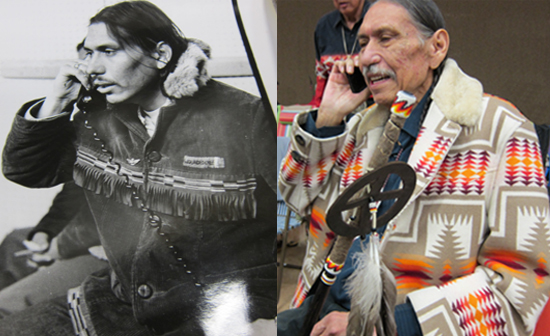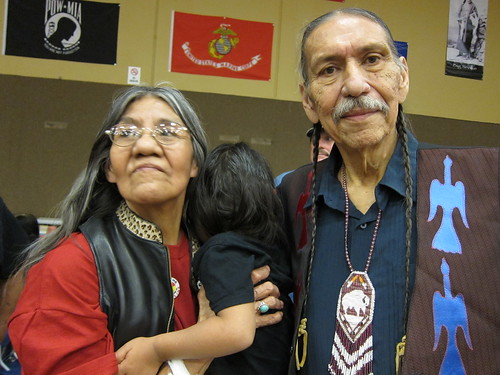Kossack cacamp created a user ID at Daily Kos on Sep 30, 2006. Who knows how long he had been lurking? He was 65 years old then. His real name was Carter Camp, the Ponca warrior who led military operations of the American Indian Movement at the 1973 Wounded Knee takeover on the Pine Ridge Reservation in South Dakota. "Our inspiration and our leader," says Meteor Blades, who participated in the takeover for 51 of its 71 days.
After a year-long battle with liver and kidney cancer, Carter walked on the afternoon of Dec. 27, 2013.
Carter was best known here for his replies correcting commenters who were misinformed on American Indian issues. My favorite comments of his were ones fileting a bullheaded "authority on everything" who wouldn't stand down to an expert. Carter's presence in the comments was initially unexpected, and to us, the newly gathering tribe of the Kossack-based Native American Netroots, a much-needed voice of authority, experience and knowledge. He was our elder, revered, respected and loved by those who knew he was about doing not just speaking. He was a modern warrior.
 Wounded Knee takeover leaders were upset by the Nixon White House's response to the siege and asked for Secretary of State Henry Kissinger to visit. Here, an interviewer asks Carter Camp if that's really necessary. Camp asks, "Why not? Indians are just as important as any other issue the U.S. has, like Vietnam."
Wounded Knee takeover leaders were upset by the Nixon White House's response to the siege and asked for Secretary of State Henry Kissinger to visit. Here, an interviewer asks Carter Camp if that's really necessary. Camp asks, "Why not? Indians are just as important as any other issue the U.S. has, like Vietnam."
Much has been written about Carter, but many have not heard of him. He was one of the original organizers of the American Indian Movement, a pan-Indian movement sparked in part by the civil rights movement of African Americans.
He led our people on the Trail of Broken Treaties caravan in 1972 from the West Coast to Washington, D.C., to protest the hundreds of broken treaties and other agreements the U.S. Government forced the tribes or their chiefs to sign.
Nixon officials refused to meet with them. That led to AIM's seven-day takeover of the BIA headquarters in Washington, D.C., which ended with some government concessions. It also led, as Meteor Blades recalls, to the liberation of BIA documents that were passed along to journalists and lawyers. "We carried out box after box of documents," inspired by the people who "stole documents from the FBI office in Media, Pennsylvania," in March 1971.
In the winter of 1973, Carter and other AIM leaders took over the small town of Wounded Knee on the Pine Ridge reservation. Gun battles during the 71-day stand-off with federal officers left three dead.
Wounded Knee was chosen for the takeover because it is the location of a massacre of at least 150 Miniconjou and Hunkpapa Lakota Indians in 1890. After their bodies had lain on the frozen ground for days, they were dumped into a mass grave by the 7th Cavalry. It was a historically appropriate site for the American Indian Movement to bring national attention to the struggles of the Lakota and all Native peoples.
At the time of the takeover, it was the view of AIM and many traditional Oglala Lakota that the Pine Ridge reservation was being terrorized by the BIA police and enforcers under the control of Tribal Chairman Dick Wilson.
Carter's sister, Casey Camp-Horinek said that unlike other AIM leaders, Carter remained at Wounded Knee throughout the entire siege with his warriors. He was also the only leader to spend two years at Leavenworth federal prison for disputed actions during the siege. For him there would be no book deals, no film roles, no adoring groupies just service to the Indian people and the respect of those who knew of his sacrifice.
As we stared silently into the darkness driving into the hamlet, I tried to foresee what opposition we would encounter and how to neutralize it. We were approaching a sacred place and each of us knew it. We could feel it deep inside. As a warrior leading warriors I humbly prayed to Wakonda for the lives of all and the wisdom to do things right. Never before or since have I offered my tobacco with such a plea or put on my feathers with such purpose. It was the birth of the Independent Oglala Nation. Things went well for us that night, we accomplished our task without loss of life. Then, in the cold darkness as we waited for Dennis and Russ to bring in the caravan (or for the fight to start), I stood on the bank of the shallow ravine where our people had been murdered by the 7th Cavalry [in 1890]. There I prayed for the defenseless ones, torn apart by Hotchkiss cannons and trampled under hooves of steel by drunken wasicu. I could feel the touch of their spirits as I eased quietly into the gully and stood silently, waiting for my future, touching my past.
In that diary, Carter responds in the comments, an excerpt:
In 1973 the fires of our traditional peoples were burning low and everyone thought they would soon die out. But a "Movement" happened across the USA led by young people who were determined not to allow that to happen. It took many years and plenty of fighting and struggle with a determined enemy who wanted our disappearance to solve his own "Indian Problem." But quitting or stopping was not an option when so much was at stake. We won, and our ways are no longer endangered with extinction. Our people have many battles yet to fight as you [Meteor Blades] and navajo outline each week in this powerful series. But the flames of our fires now burn from shore to shore on this, our turtle island, and they will never go out. At Wounded Knee in 1890 the Americans thought they had won a final solution. But, at Wounded Knee in 1973 we showed the world how wrong they were as we relit the ancient fires of the Nations. I'm proud of that.
 Carter Camp posing at Wounded Knee during the filming of Lakota Woman, decades after the takeover
Carter Camp posing at Wounded Knee during the filming of Lakota Woman, decades after the takeover
The Wounded Knee takeover brought international media attention to the plight of American Indians and also energized the rest of the Indian Nations. To this day, American Indians credit this event from 1973 for empowering our tribes, along with the occupation of Alcatraz in 1969 and the BIA takeover.
Carter continued his work right into his last year on this earth, by protesting the Keystone XL pipeline, even after he had fallen ill.
In April of 2013, Carter's family planned an Honor Dance for him. When I was informed about the event I knew I had to attend as it was my one and only chance to meet my hero. It was an amazing event and really lifted Carter's spirits. So much so that he defied medical predictions and was able to attend his beloved Sun Dance, one last time, this past August. The Sun Dance, which Carter had helped organize annually for decades, was led by the spiritual leader of the Rosebud reservation, Leonard Crow Dog, who also officiated at Carter's final ceremony.
At the Honor Dance, Carter told the crowd that our group here at Daily Kos, Native American Netroots, was part of the new wave of Indian activism. That technology is now connecting us all and can make us stronger.
On display at the honor dance were Casey Camp-Horinek's personal collection of AP photos of the Wounded Knee takeover. I took a snapshot of the one below and recently realized it mirrored one I took of Carter that day:
 L-R: AP photo of Carter Camp at Wounded Knee in 1973, my photo of Carter in 2013 at the 40th reunion of Wounded Knee vets at his Honor Dance, in the latest one he happens to be talking on my phone with Meteor Blades whom Carter greatly respected.
L-R: AP photo of Carter Camp at Wounded Knee in 1973, my photo of Carter in 2013 at the 40th reunion of Wounded Knee vets at his Honor Dance, in the latest one he happens to be talking on my phone with Meteor Blades whom Carter greatly respected.
Carter always kept his sense of humor. On a phone call I had with him after the Sun Dance he said that when people ask him how he's feeling he replies that it's only a case of fatal ennui, and not to worry. At the time he said he was forcing himself to go out and water the tomatoes to keep active. We laughed together. I hung up the phone and wept at the thought of how much I would miss him.
At his blog, Ben Carnes, a family friend, wrote a lovely entry about Carter's life. Below is his account of the final ceremony:
Postcript: Yesterday evening after conclusion of ceremonies at the center, Carter led us in his last caravan to his final resting place at the Ponca Tribal Cemetery. I estimated a two-mile procession as vehicles pulled over on both sides of the highway a show of respect. As we turned left towards the cemetery, I saw one elderly Indian man who had parked on the side of the road and stood beside his truck, a solitary figure wrapped in a blanket with his fist held high in the air giving honor to a warrior. It was a very tearful moment for me seeing this. At graveside more prayers were offered and written statements were read, including one from Leonard Peltier. Then it was done, families and friends began making the trip home. As I drove home, I reflected upon the past few days. It had ranged from sadness/grief to exuberance and celebration when it was announced that Carter Camp would be receiving a citation from the State of Oklahoma recognizing him for his lifetime of service to Native people.
Julie Horinek, Carter's niece and the daughter of Casey Camp-Horinek said:
Today I was blessed to be a part of a ceremony and a celebration to send my Uncle Carter on his way to the stars—one befitting a Sun Dance chief and a true warrior.
Carter was preceded in death by his parents and sister Darlena Overland. He is survived by his wife Linda Carson Camp and sons Kenny, Jeremy, Victorio, Mazhonaposhe, and Augustus. Also sister Casey Camp-Horinek and brothers Craig and Dwain Camp. Carter also leaves behind numerous nieces and nephews, a large extended family and innumerable friends from across the nation. Casket Bearers will be; Kenny Camp, Jeremy Reed, Victorio Camp, Mazhonaposhe, Ahmbaska Camp, Augustus Camp, and Frank Carson.
|
Carter, thank you for giving your entire life to the defense and survival of American Indian culture.
 Linda and Carter Camp with sleeping grandchild, taken on April 20, 2013 by Neeta Lind
Linda and Carter Camp with sleeping grandchild, taken on April 20, 2013 by Neeta Lind
|
Additional Reading or Viewing Options: • Aji's must-read diary containing Ponca history: This Week In American Indian News: Carter Camp's Ponca Nation
 Carter Camp being interviewed for the
Carter Camp being interviewed for the
2009 PBS special, "We Shall Remain."
There is a excellent PBS documentary about the Wounded Knee takeover and siege on the Pine Ridge Reservation. Carter Camp is featured in this 80-minute segment,
We Shall Remain, Wounded Knee, Episode 5.
h/t to the late exmearden


